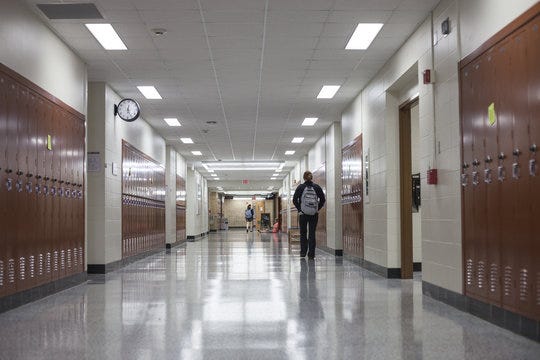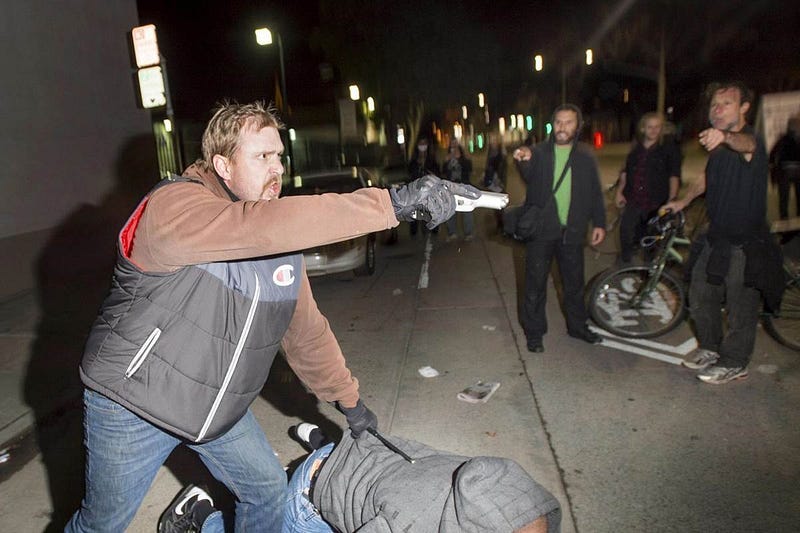Ohio is buying mobile shoot houses to train armed teachers
Portable structure that simulate the layout of residential homes don't match the real-world circumstances of surprise attacks by students inside classrooms, hallways, and cafeterias.
Why is it worth my time to write (and yours to read) about a relatively small purchase in Ohio? This is just one example of the death by a thousand cuts that school budgets are facing as politicians push useless—or even harmful—“security theater” onto campuses. Schools across the country are bracing for widespread teacher and support staff layoffs while purchases like this whittle away a dollars that could be spent on essential items and services.
Ohio recently approved the purchase of two $78,000 "mobile shoot houses" to train armed staff at schools. The idea for this tactical teacher training comes as 77 school districts in Ohio now allow staff to be armed on campus.
For those in education who are unfamiliar with military and SWAT training, a mobile shoot house is a modular structure of wall panels that can be setup to simulate the inside of a house for police to practice moving through as a team.
From the vendor's website, the standard mobile shoot house package provides 700 sq. ft. of modular space. The largest available is 2,000 sq. ft. The narrow maze hallways in the photo approximates a residential home and is marketed for a SWAT team practicing drug raids. In addition to these training props, the vendor sells surveillance systems, body armor, and gun turrets for armored SWAT vehicles.
Unlike the mobile shoot house layout, an average school classroom is about 1,000 sq. ft. and the hallway along just one classroom wall is about 360 sq. ft. A semi-realistic school training environment with two classrooms and a hallway would need a minimum of 2,720 sq ft.
Some facts about shootings on campus:
70% are outside.
When there is a shooting inside, it's most likely to be a fight that escalates into a shooting in a common area like a hallway, entryway, or cafeteria. During this spontaneous gun violence, the shooter almost always flees meaning there is no risk to anyone else on campus.
In the case of a deliberate, preplanned attacks at schools, half begin and end inside the same room.
During these planned school shootings, the shooter is most often a student committing a surprise attack that starts inside the school.
To practice for real-world school shooting scenarios, a teacher at the front of the room needs to spot a student taking a gun out of a backpack, pull their own concealed weapon, and fire a precise shot across the crowded classroom. I think it’s very unlikely that Ohio's state sponsored training has teachers practicing taking shots at students.
With limited time and space in the shoot house, the teachers are probably practicing firing at an assailant who is alone in a room without any bystander students to accidentally strike. A couple of missed shots in an empty room won’t seem like a big deal during a training session. In a real classroom, every miss can be deadly.
If a mobile shoot house isn't large enough to replicate a school layout and doesn’t provide a realistic scenario for a staff member, what's the purpose of this purchase?
On top of that, there are 3,100 schools in Ohio so it will take +5 years just to hold one full day training session with these mobile shoot houses at each school. For a school with one hundred staff members, they each get about 4 minutes of training time if the training simulations run continuously for 8 hours without any breaks.
False Confidence
Assume that a teacher has taken 4 minutes of tactical training and is armed inside their classroom when there is a call for an active shooter on campus. Is this teacher really prepared to operate in a high stress environment and make split second decisions to shoot/not shoot each student and other staff member they encounter in the hallway?
If they find an assailant in body armor with a rifle who has been practicing and preparing for the surprise attack for months, is a teacher with 4 minutes of shoot house training adequately prepared to “neutralize” the same threat that psychologically paralyzed hundreds of officers with rifles and ballistic shields in Uvalde, TX?
On the policy side, before any teacher is armed on campus there needs to be a clear Use of Force Continuum that explains when it’s justified for a teacher to shoot a student.
As I wrote back in 2017, armed Samaritans—which includes armed teachers—present more risks than rewards:
As soon as you draw your weapon, you are indistinguishable from the active shooter. During the 2013 shooting at the Navy Yard in Washington, DC, dozens of plain clothes officers from multiple agencies responded to the scene. Bystanders at the scene called 911 with multiple descriptions and locations of the shooter because they confused plain clothes officers with the attacker.
The confusion caused by the misinterpretation of good guys versus bad guys causes misdirection and waste of critical time and resources. During the Las Vegas shooting, there were continued reports of multiple shooters and it took 72 minutes to declare the “all clear” when the shooter had already been dead for more than an hour.
Additional Costs
$78,000 for the structure is only the tip of the iceberg for the cost of training teachers to be tactical operators. Contract creep is a rampant problem across all levels of governments. One small purchase can open the door for millions of dollars in subsequent spending once a jurisdiction is pot-committed to the initial purchase.
To run a training session at a school, there are also costs for:
Instructors: private contractors, police on overtime, or police detailed to the school instead of other duties.
Setup: Assembling and breaking down the walls of the structure.
Supplies: Weapons, simulated ammunition, props, targets, dummies, safety gear (jackets, vests, safety glasses, face shields).
Transport: Truck, trailer, forklift, and commercial vehicle driver to move the wall panels from schools to school.
Teacher Overtime: Union isn’t going to be happy if teachers are attending training sessions without compensation.
Maintenance: Setting up, breaking down, and moving the panels every day is going to cause wear and tear that requires ongoing maintenance.
These costs could quickly balloon into millions of dollars that are spread across local school systems and police department budgets. Five instructors per shoot house at $50/hour running 300 sessions a year is $1.2M just for the instructor’s labor. Experienced tactical training officers are probably way more than $50/hr meaning the instructor cost alone could be millions of dollars (that may find its way to the same company who has lobbied the state for the initial purchase).
Security Theater
This purchase in Ohio comes at the same time when Oregon school districts have announced $10-30 million budget shortfalls that will require cutting school security, librarians, and music programs. It’s not like there is surplus money in Ohio, Cleveland Public Schools have a $140 million budget deficit and Akron Public Schools are projecting $16 million in cuts for 2025. School districts across Ohio are already operating in the red.
Where is the money coming from to purchase this equipment and why is a shoot house being prioritized ahead of budget shortfalls? What’s the long-term plan for sustainment of this purchase and why aren’t the millions of dollars in labor to use these products part of the original state budget line?
Buying a product just for a press release and media coverage is "security theater" not school safety. There is no feasible way that these two shoot houses have a positive impact on improving school safety in Ohio.
David Riedman is the creator of the K-12 School Shooting Database. Listen to my new podcast Back to School Shootings, or catch-up on my prior interviews including Freakonomics Radio and New England Journal of Medicine.






![Building Product: Mobile Modular Shoot House [1033307] | ARCAT Building Product: Mobile Modular Shoot House [1033307] | ARCAT](https://substackcdn.com/image/fetch/$s_!IZLS!,w_1456,c_limit,f_auto,q_auto:good,fl_progressive:steep/https%3A%2F%2Fsubstack-post-media.s3.amazonaws.com%2Fpublic%2Fimages%2Fdc46354a-9196-42fb-9eeb-60d2840fd18f_1500x1500.jpeg)
